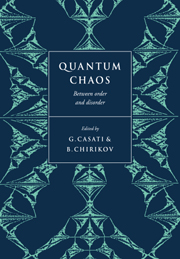Book contents
- Frontmatter
- Contents
- Preface
- Acknowledgments
- Introduction
- Part One Classical chaos and quantum localization
- Stochastic behaviour of a quantum pendulum under a periodic perturbation
- Quantum dynamics of a nonintegrable system
- Excitation of molecular rotation by periodic microwave pulses. A testing ground for Anderson localization
- Localization of diffusive excitation in multi-level systems
- Classical and quantum chaos for a kicked top
- Self-similarity in quantum dynamics
- Time irreversibility of classically chaotic quantum dynamics
- Effect of noise on time-dependent quantum chaos
- Dynamical localization, dissipation and noise
- Maximum entropy models and quantum transmssion in disordered systems
- Solid state “atoms” in intense oscillating fields
- Part Two Atoms in strong fields
- Part Three Semiclassical approximations
- Part Four Level statistics and random matrix theory
- Index
Self-similarity in quantum dynamics
Published online by Cambridge University Press: 07 May 2010
- Frontmatter
- Contents
- Preface
- Acknowledgments
- Introduction
- Part One Classical chaos and quantum localization
- Stochastic behaviour of a quantum pendulum under a periodic perturbation
- Quantum dynamics of a nonintegrable system
- Excitation of molecular rotation by periodic microwave pulses. A testing ground for Anderson localization
- Localization of diffusive excitation in multi-level systems
- Classical and quantum chaos for a kicked top
- Self-similarity in quantum dynamics
- Time irreversibility of classically chaotic quantum dynamics
- Effect of noise on time-dependent quantum chaos
- Dynamical localization, dissipation and noise
- Maximum entropy models and quantum transmssion in disordered systems
- Solid state “atoms” in intense oscillating fields
- Part Two Atoms in strong fields
- Part Three Semiclassical approximations
- Part Four Level statistics and random matrix theory
- Index
Summary
We have developed a renormalization transformation, based on the existence of higher-order nonlinear resonances in the double-resonance model, that gives good predictions for the extension of the wave function in that system due to nonlinear resonance overlap. The double-resonance model describes the qualitative behavior, in local regions of the Hilbert space, of many quantum systems with two degrees of freedom whose dynamics is described by a nonlinear Hamiltonian but a linear Schrödinger equation.
INTRODUCTION
The phase space of nonlinear nonintegrable classical conservative systems exhibits extremely complex structure consisting of regular Kolmogorov-Arnold-Moser (KAM) tori intermixed with chaos. In some regions of the phase space the structure is self-similar to all length scales and exhibits scaling behavior in space and time. KAM tori are the remnants of global conserved quantities. For many systems, when some parameter which characterizes the size of the nonlinearity is small, KAM tori dominate the phase space. However, as the nonlinearity parameter is increased in size, nonlinear resonances in the system grow and overlap and destroy KAM tori lying between them. The existence of KAM tori can have a profound effect on the dynamics of a conservative system with two degrees of freedom because some KAM tori can divide the phase space into disjoint parts. When such a KAM torus is destroyed by nonlinear resonance overlap, the dynamics of the classical system may change dramatically.
The mechanism by which KAM surfaces are destroyed by nonlinear resonances has been studied extensively by Greene, Shenker and Kadanoff, MacKay, and others. KAM tori have irrational winding numbers. Each irrational winding number can be represented uniquely by a continued fraction.
- Type
- Chapter
- Information
- Quantum ChaosBetween Order and Disorder, pp. 127 - 146Publisher: Cambridge University PressPrint publication year: 1995

